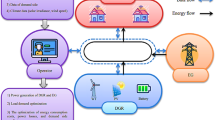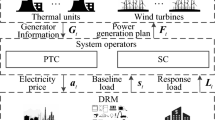Abstract
With the emerging deregulated electricity markets, a part of the electricity trading takes place in day-ahead markets where producers and retailers place bids in order to maximize their profit. We present a price-maker model for strategic bidding from the perspective of a producer in Price Coupled Regions (PCR) considering a capacitated transmission network between local day-ahead markets. The aim for the bidder is to establish a production plan and set its bids taking into consideration the reaction of the market. We consider the problem as deterministic, that is, the bids of the competitors are known in advance. We are facing a bilevel optimization problem where the first level is a Unit Commitment problem, modeled as a Mixed Integer Linear Program (MILP), and the second level models a market equilibrium problem through a Linear Program. The problem is first reformulated as a single level problem. Properties of the optimal spot prices are studied to obtain an extended formulation that is linearized and tightened using new valid inequalities. Several properties of the spot prices allow to reduce significantly the number of binary variables. Two novel heuristics are proposed, the first applicable in PCR, the second for general formulations with Special Ordered Sets (SOS) of type 1. Our computational experiments highlights the risk of a loss for the bidder if some aspects usually not considered in the literature, such as Price Coupled Regions, or an accurate UC problem, are not taken into account. They also show that the reformulation techniques, combined with new valid inequalities, allow to solve much larger instances than the current state-of-the-art. Finally, our experiments also show that the proposed heuristics deliver very high quality solutions in a short computation time.



















Similar content being viewed by others
References
Baker KR, Taylor RE (1979) A linear programming ramework for cost allocation and external acquisition when reciprocal services exist. Account Rev 54(4):784–790
Bakirtzis AG, Ziogos MP, Tellidou AC, Bakirtzis GA (2007) Electricity producer offering strategies in day-ahead energy market with step-wise offers. IEEE Trans Power Syst 22:1804–1818
Balachandran BV, Ramakrishnan RT (1996) Joint cost allocation for multiple lots. Manage Sci 42(2):247–258
Beale E, Forrest J (1976) Global optimization using special ordered sets. Math Program 10:52–69
Bertsimas D, Sim M (2003) Robust discrete optimization and network flows. Math Program B 98:49–71
Carrión M, Arroyo JM (2006) A computationally efficient mixed-integer linear formulation for the thermal unit commitment problem. IEEE Trans Power Syst 21(3):1371–1378
Chen R, Paschalidis IC, Caramanis MC, Andianesis P (2018) Learning from past bids to participate strategically in day-ahead electricity markets.pdf. arXiv:1811.06113
Clements AE, Hurn AS, Li Z (2016) Strategic bidding and rebidding in electricity markets. Energy Econ 59:24–36
Conforti M, Cornuéjols G, Zambelli G (2010) Extended formulations in combinatorial optimization. 4OR, 8:1–48
Cruz M, Finardi E, de Matos V, Luna J (2016) Strategic bidding for price-maker producers in predominantly hydroelectric systems. Electr Power Syst Res 140:435–444
Dalby E (2017) Stratégies d’offre sur le marché électrique. Master’s thesis, Sorbonne Universities
de la Torre S, Arroyo JM, Conejo AJ, Contreras J (2002) Price maker self-scheduling in a pool-based electricity market: a mixed-integer lp approach. IEEE Trans Power Syst 17(4):1037–1042
EUPHEMIA. Euphemia public description. https://www.nordpoolspot.com/globalassets/download-center/pcr/euphemia-public-documentation.pdf, (2016)
Hogan WW (2012) Multiple market-clearing prices, electricity market design and price manipulation. Electric J 25(4):18–32
Kardakos EG, Simoglou CK, Bakirtzis AG (2014) Optimal bidding strategy in transmission-constrained electricity markets. Electr Power Syst Res 109:141–149
Koltsaklis N, Gioulekas I, Georgiadis M (2018) Reprint of: Optimal scheduling of interconnected power systems. Comput Chem Eng 116:212–230
Koltsaklis NE, Dagoumas AS (2018) Incorporating unit commitment aspects to the European electricity markets t algorithm: an optimization model for the joint clearing of energy and reserve markets. Appl Energy 231:235–258
Li G, Shi J, Qu X (2011) Modeling methods for genco bidding strategy optimization in the liberalized electricity spot markete: A state-of-the-art review. Energy 36:4686–4700
Luo ZQ, Pang JS, Ralph D (1996) Mathematical programs with equilibrium constraints. Cambridge University Press, Cambridge
Madani M, Van Vyve M (2015) Computationally efficient mip formulation and algorithms for European day-ahead electricity market auctions. Eur J Oper Res 242:580–593
Morales JM, Conejo AJ, Madsen H, Pinson P, Zugno M (2014) Integrating Renewables in Electricity Markets, volume 205 of International Seriers in Operations Research & Management Science. Springer
Ostrowski J, Anjos MF, Vannelli A (2012) Tight mixed integer linear programming formulations for the unit commitment problem. IEEE Trans Power Syst 27:39–46
Pereira MV, Granville S, Fampa MHC, Dix R, Barroso LA (2005) Strategic bidding under uncertainty: a binary expansion approach. IEEE Trans Power Syst 20:180–188
Rogers DF, Plante RD, Wong RT, Evans JR (1991) Aggregation and disaggregation techniques and methodology in optimization. Oper Res 39(4):553–582
Ruiz C, Conejo AJ (2009) Pool strategy of a producer with endogenous formation of locational marginal prices. IEEE Trans Power Syst 24(4):1855–1866
Sherali HD, Adams WP (1994) A hierarchy of relaxations and convex hull characterizations for mixed-integer zero-one programming problems. Discrete Appl Math 52:83–106
Sherali HD, Adams WP (1999) A reformulation-linearization technique for solving discrete and continuous nonconvex problems. Springer, New York
Steeger G, Barroso LA, Rebennack S (2014) Optimal bidding strategies for hydro-electric producers: a literature survey. IEEE Trans Power Syst 29:1758–1766
Tahanan M, van Ackooij W, Frangioni A, Lacalandra F (2015) Large-scale unit commitment under uncertainty: a literature survey. 4OR 13(2):115–171
Acknowledgements
This research benefited from the support of the FMJH Program PGMO and from the support of EDF, Thales, Orange.
Author information
Authors and Affiliations
Corresponding author
Additional information
Publisher's Note
Springer Nature remains neutral with regard to jurisdictional claims in published maps and institutional affiliations.
Appendices
BP-MILP formulation
BP\(^M\)-MILP formulation
\({\overline{Q}}^t_{jn} :\) maximum production capacity of generator j at node n in period t,
\(P^t_{ijn}\) : \(t \in T, n \in N, j \in J_n, i \in I^t_n\).
BP\(^M\)-MILP is obtained from BP-MILP, replacing constraints (19a) by
and by adding the following constraints:
BP-\(\{N\}\) formulation
UC formulation from Ostrowski et al. (2012)
Formulation is given for a single node. Data:
-
\(J\): set of production units (generators)
-
\({\underline{P}}_j, {\overline{P}}_j\): lower and upper bound on production level of unit \(j\) over one time period
-
\(A_j\) : fixed cost for a generator is turned on
-
\(NL_j\): number of segments for production cost of unit \(j\)
-
\(F_{lj}\): unit cost on segment \(l\) of unit \(j\)
-
\(T_{lj}\): upper bound on accumulated production up to segment \(l\) of unit \(j\)
-
\(UT_j, DT_j\): minimum up and down times for unit \(j\)
-
\(K_j, C_j\): Ramping up/down costs
-
\(RU_j, RD_j\): ramping up/down rates
-
\(SU_j, SD_j\): start/stop rates
-
\(p^0_j\): initial production of unit \(j\)
-
\(L_j\): number of periods unit \(j\) must be initially offline due to its minimum down time constraint
-
\(G_j\): number of periods unit \(j\) must be initially online due to its minimum up time constraint
Variables:
-
\(p^t \ge 0\): energy bidding in period \(t\) in the node.
-
\(p_j(t) \ge 0\): energy produced in period \(t\) by unit \(j\)
-
\(c(p)\): total production cost for \(\{p_j(t)\}_{\{j \in J, t \in T\}}\)
-
\(\varTheta _l(j,t) \ge 0\): energy produced by \(j\) in period \(t\) on segment \(l\)
-
\(v_j(t) \in \{0,1\}\): indicates if unit \(j\) is active at period \(t\)
-
\(y_j(t) \in \{0,1\}\): indicates if unit \(j\) is started at period \(t\)
-
\(z_j(t) \in \{0,1\}\): indicates if unit \(j\) is turned-off at period \(t\)
-
\(c^p_j(t)\): production cost of unit \(j\) at period \(t\)
-
\(c^u_j(t)\): ramping up cost of unit \(j\) at period \(t\)
-
\(c^d_j(t)\): ramping down cost of unit \(j\) at period \(t\)
Rights and permissions
About this article
Cite this article
De Boeck, J., Brotcorne, L. & Fortz, B. Strategic bidding in price coupled regions. Math Meth Oper Res 95, 365–407 (2022). https://doi.org/10.1007/s00186-021-00768-4
Received:
Revised:
Accepted:
Published:
Issue Date:
DOI: https://doi.org/10.1007/s00186-021-00768-4




